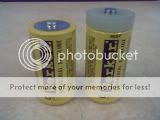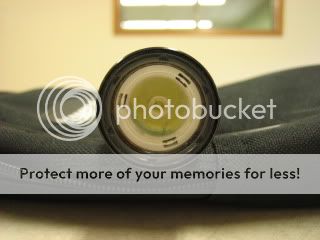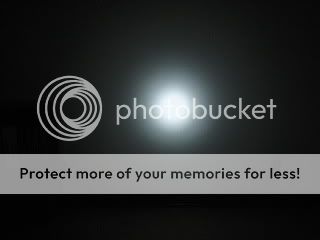Kestrel
Flashaholic
A narrative of the FM C-cell "C" bodies - getting the maximum performance from 2xC & 3xC Alkaline cells and the SureFire KT-2 Turbohead.
Synopsis: A low voltage LED tower can be built to significantly outperform the Malkoff M30 in a low-voltage configuration (i.e ~2.5v), using standard 'Alkaline C' cells.
Comparison pics to the standard SureFire C3 / Malkoff M60 / 2x17500, with beamshots.
Edit: Additional beamshots with the low voltage Malkoff M30 in the FM C-cell "C" bodies as a comparison have just been added.
Earlier this year, FM introduced the C-cell C-bodies which accepted standard SF P60-type lamp assemblies. There was significant initial interest in these bodies, as they were designed for using AW protected LiIon C cells of 3300 mAh capacity, providing both high output and very long potential runtimes with LED modules such as the Malkoff M60. However, these LiIon C cells were out of stock & soon to be officially discontinued. Problem to be solved: Once these FM bodies were purchased, what can be done with them? Being interested in maximum efficiency, I decided to pursue the maximum possible performance from these C-cell bodies while using commonly available Alkaline C cells. This left two options: using the excellent low-voltage Malkoff M30 with these bodies, or getting a custom-built LED tower and pairing that with the SF KT-2 turbohead. The second option has the advantage of getting a very high degree of throw while retaining excellent beam quality. Either option would make good use of the very long runtimes available from C-size cells.
It should be noted that these bodies were designed for the 3mm longer LiIon C cells. Since connection is intermittent while using the Malkoff M30 drop-in (which uses a rather short contact spring), I had a simple 6mm spacer fabricated of insulating fiberglass and a pressed-in stainless steel insert. The somewhat longer spring of the LED tower permits the shorter alkaline cells to be used without requiring a spacer in the FM 2xC, which was a nice surprise. There were absolutely no connection issues in the tested configurations.



CPF'er Justin Case built the LED tower using a neutral-tint SSC P4, driven by the extremely efficient BadBoy NexGen 1000 regulated driver board. This driver was necessary to wring the highest possible performance from alkaline cells which are quite limited in their ability to supply high currents. My sincere thanks to him for his extensive research into finding an excellent solution for these configurations. His initial evaluation after building this LED tower is that it would produce ~200 lumens from 2x NiMH AA cells, an impressive achievement compared to the Malkoff M30, which produces ~120 lumens from the same cells. If/when NiMH C-sized cells are used in the 2xC body, this tower should produce the ~240 lumen rated maximum due to the higher current capabilities of NiMH C & less voltage drop. The tower should also have no difficulty attaining a 240 lumen output with the 3xC body.

First, some comparison photos of the various configurations.
The SureFire C3 / M60 / 2x17500, a standard on CPF with excellent overall performance:

The FM 2xC & 3xC bodies, with either the SureFire KT-2 Turbohead or the standard SureFire bezels:
(It has been noted elsewhere that the FM 3xC is of comparable length or slightly shorter than the Mag 2C.)




The business end of the LED tower in the 2.5" SF KT-2 Turbohead vs. a Malkoff in a standard SF bezel:
(The distance to the camera is the same, amazingly enough.)


Initial impressions with Ceiling Bounce: The output from the LED tower on 2xC was nearly as high as the output from the 240 lumen M60 standard, while the output from the M30 on 2xC was noticibly less. The output from the LED tower on 3xC was comparable to the M60, while the M30 on 3xC managed to catch up, as it is now running at ~3.6v and should be comparable to the M60 at ~7.4v.
Initial impressions outdoors: The throw of the LED tower in the FM 2xC w/ KT-2 TH was at least equal and possibly greater than the high-voltage M60 configuration. This is interesting in light of the fact that the M60 is consuming ~4.5W of power, while the LED tower is consuming a miserly ~2.5W. Obviously there was less spill from the TH, but this build was done to achieve maximum throw for minimum consumed power, while using commonly-available alkaline C cells. In addition, runtime should be excellent, with at least 3 hours of regulation in 2xC with many more hours of gradually declining light output. Performance with 3xC should be even better, with greater output as well as longer runtime. I may do a runtime test in a few days. However, without a light meter, it is difficult to determine when the LED falls out of regulation with cells that exhibit such a gradual decline in output.
Edit: Runtime test information in post # 33.
And now for the beamshots.:thumbsup:
All photos were taken at a distance of 7 feet, with the flashlights 6 feet from the wall.
Keep in mind that the M60 beamshots represent ~4.5 watts of consumed power, while the LED tower beamshots represent only ~2.5 watts of consumed power. Even though Alkaline C cells are not very energy-dense, the extremely low power consumption will result in extremely long runtimes. Regulated runtimes on alkaline C's should be in the 3-4 hour range, with long graceful declines of ~4 hours of more-than-adequate performance. :huh:
Darkened room:

A SureFire C3 with the M60 and 2x17500 was used as a (high-voltage) comparison standard:
(This particular M60 is an extraordinary one, a little on the warm side, and exhibiting virtually no rings.)

FM 2xC w/ SF Turbohead:___________________FM 2xC w/ Malkoff M30:
(Note that both hotspots are saturating the camera making maximum brightness comparisons between the two configurations difficult. Underexposed beamshots are later in the post which do a better job of representing the brightness of the hotspots. However, note the significantly greater spill from the M30.)


FM 3xC w/ SF Turbohead:___________________FM 3xC w/ Malkoff M30:
(the slightly increased spill (compared to 2xC) in the Turbohead photograph below left, was real, and not a photographic artifact)


Streamlight Stylus Pro 2xAAA alkaline:
(a 20 lumen penlight with decent throw as a low-end comparison)

Darkened room, underexposed:

SureFire C3 / Malkoff M60 / 2x17500 (high-voltage) comparison, underexposed:

FM 2xC w/ SF Turbohead, underexposed:_______FM 2xC w/ Malkoff M30, underexposed:
(Note that the hot spot from the Turbohead (below, left) appears to be quite intense, and is somewhat superior to the high-voltage M60 configuration above. It also soundly trumps the adjacent M30 hotspot to the right (both are running at 2.5v), at which voltage the M30 significantly underperforms the LED tower in total output. This was the primary goal of this build.)


FM 3xC w/ SF Turbohead, underexposed:_______FM 3xC w/ Malkoff M30, underexposed:
(An excellent 240 lumen spot below, focused by the top-class SF KT-2 Turbohead. Although the total lumen output should be comparable to the lumen output from the adjacent M30 now that the M30 is running at spec (3.7-3.8v), the hotspot from the TH is considerably brighter, with much less spill.)


Conclusions: I am extremely impressed with both of these Alkaline C configurations combined with the SureFire 2.5" Turbohead. The resultant hotspots are very intense, exceeding the performance from the much higher wattage Malkoff M60 / 2x17500. It was interesting to note that the LED tower was able to achieve near-maximum performance from 2xC alkaline, with modest gains going to 3xC, while the Malkoff M30 exhibited only modest performance from 2xC and gaining quite a bit going to 3xC.
I also expect that runtimes on 3xC will be longer with the LED tower than with the M30, as the LED tower uses the BadBoy NexGen driver with less internal voltage drop.
Synopsis: A low voltage LED tower can be built to significantly outperform the Malkoff M30 in a low-voltage configuration (i.e ~2.5v), using standard 'Alkaline C' cells.
Comparison pics to the standard SureFire C3 / Malkoff M60 / 2x17500, with beamshots.
Edit: Additional beamshots with the low voltage Malkoff M30 in the FM C-cell "C" bodies as a comparison have just been added.
Earlier this year, FM introduced the C-cell C-bodies which accepted standard SF P60-type lamp assemblies. There was significant initial interest in these bodies, as they were designed for using AW protected LiIon C cells of 3300 mAh capacity, providing both high output and very long potential runtimes with LED modules such as the Malkoff M60. However, these LiIon C cells were out of stock & soon to be officially discontinued. Problem to be solved: Once these FM bodies were purchased, what can be done with them? Being interested in maximum efficiency, I decided to pursue the maximum possible performance from these C-cell bodies while using commonly available Alkaline C cells. This left two options: using the excellent low-voltage Malkoff M30 with these bodies, or getting a custom-built LED tower and pairing that with the SF KT-2 turbohead. The second option has the advantage of getting a very high degree of throw while retaining excellent beam quality. Either option would make good use of the very long runtimes available from C-size cells.
It should be noted that these bodies were designed for the 3mm longer LiIon C cells. Since connection is intermittent while using the Malkoff M30 drop-in (which uses a rather short contact spring), I had a simple 6mm spacer fabricated of insulating fiberglass and a pressed-in stainless steel insert. The somewhat longer spring of the LED tower permits the shorter alkaline cells to be used without requiring a spacer in the FM 2xC, which was a nice surprise. There were absolutely no connection issues in the tested configurations.



CPF'er Justin Case built the LED tower using a neutral-tint SSC P4, driven by the extremely efficient BadBoy NexGen 1000 regulated driver board. This driver was necessary to wring the highest possible performance from alkaline cells which are quite limited in their ability to supply high currents. My sincere thanks to him for his extensive research into finding an excellent solution for these configurations. His initial evaluation after building this LED tower is that it would produce ~200 lumens from 2x NiMH AA cells, an impressive achievement compared to the Malkoff M30, which produces ~120 lumens from the same cells. If/when NiMH C-sized cells are used in the 2xC body, this tower should produce the ~240 lumen rated maximum due to the higher current capabilities of NiMH C & less voltage drop. The tower should also have no difficulty attaining a 240 lumen output with the 3xC body.

First, some comparison photos of the various configurations.
The SureFire C3 / M60 / 2x17500, a standard on CPF with excellent overall performance:

The FM 2xC & 3xC bodies, with either the SureFire KT-2 Turbohead or the standard SureFire bezels:
(It has been noted elsewhere that the FM 3xC is of comparable length or slightly shorter than the Mag 2C.)




The business end of the LED tower in the 2.5" SF KT-2 Turbohead vs. a Malkoff in a standard SF bezel:
(The distance to the camera is the same, amazingly enough.)


Initial impressions with Ceiling Bounce: The output from the LED tower on 2xC was nearly as high as the output from the 240 lumen M60 standard, while the output from the M30 on 2xC was noticibly less. The output from the LED tower on 3xC was comparable to the M60, while the M30 on 3xC managed to catch up, as it is now running at ~3.6v and should be comparable to the M60 at ~7.4v.
Initial impressions outdoors: The throw of the LED tower in the FM 2xC w/ KT-2 TH was at least equal and possibly greater than the high-voltage M60 configuration. This is interesting in light of the fact that the M60 is consuming ~4.5W of power, while the LED tower is consuming a miserly ~2.5W. Obviously there was less spill from the TH, but this build was done to achieve maximum throw for minimum consumed power, while using commonly-available alkaline C cells. In addition, runtime should be excellent, with at least 3 hours of regulation in 2xC with many more hours of gradually declining light output. Performance with 3xC should be even better, with greater output as well as longer runtime. I may do a runtime test in a few days. However, without a light meter, it is difficult to determine when the LED falls out of regulation with cells that exhibit such a gradual decline in output.
Edit: Runtime test information in post # 33.
And now for the beamshots.:thumbsup:
All photos were taken at a distance of 7 feet, with the flashlights 6 feet from the wall.
Keep in mind that the M60 beamshots represent ~4.5 watts of consumed power, while the LED tower beamshots represent only ~2.5 watts of consumed power. Even though Alkaline C cells are not very energy-dense, the extremely low power consumption will result in extremely long runtimes. Regulated runtimes on alkaline C's should be in the 3-4 hour range, with long graceful declines of ~4 hours of more-than-adequate performance. :huh:
Darkened room:

A SureFire C3 with the M60 and 2x17500 was used as a (high-voltage) comparison standard:
(This particular M60 is an extraordinary one, a little on the warm side, and exhibiting virtually no rings.)

FM 2xC w/ SF Turbohead:___________________FM 2xC w/ Malkoff M30:
(Note that both hotspots are saturating the camera making maximum brightness comparisons between the two configurations difficult. Underexposed beamshots are later in the post which do a better job of representing the brightness of the hotspots. However, note the significantly greater spill from the M30.)


FM 3xC w/ SF Turbohead:___________________FM 3xC w/ Malkoff M30:
(the slightly increased spill (compared to 2xC) in the Turbohead photograph below left, was real, and not a photographic artifact)


Streamlight Stylus Pro 2xAAA alkaline:
(a 20 lumen penlight with decent throw as a low-end comparison)

Darkened room, underexposed:

SureFire C3 / Malkoff M60 / 2x17500 (high-voltage) comparison, underexposed:

FM 2xC w/ SF Turbohead, underexposed:_______FM 2xC w/ Malkoff M30, underexposed:
(Note that the hot spot from the Turbohead (below, left) appears to be quite intense, and is somewhat superior to the high-voltage M60 configuration above. It also soundly trumps the adjacent M30 hotspot to the right (both are running at 2.5v), at which voltage the M30 significantly underperforms the LED tower in total output. This was the primary goal of this build.)


FM 3xC w/ SF Turbohead, underexposed:_______FM 3xC w/ Malkoff M30, underexposed:
(An excellent 240 lumen spot below, focused by the top-class SF KT-2 Turbohead. Although the total lumen output should be comparable to the lumen output from the adjacent M30 now that the M30 is running at spec (3.7-3.8v), the hotspot from the TH is considerably brighter, with much less spill.)


Conclusions: I am extremely impressed with both of these Alkaline C configurations combined with the SureFire 2.5" Turbohead. The resultant hotspots are very intense, exceeding the performance from the much higher wattage Malkoff M60 / 2x17500. It was interesting to note that the LED tower was able to achieve near-maximum performance from 2xC alkaline, with modest gains going to 3xC, while the Malkoff M30 exhibited only modest performance from 2xC and gaining quite a bit going to 3xC.
I also expect that runtimes on 3xC will be longer with the LED tower than with the M30, as the LED tower uses the BadBoy NexGen driver with less internal voltage drop.
Last edited:


